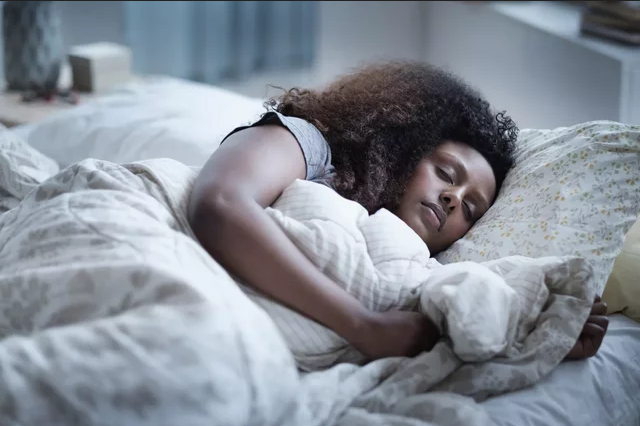
Believe it or not, there are ways to slow down signs of aging, such as wrinkles
, overnight. However, sleeping in the wrong position can thwart your efforts to avoid having lines on your face.
According to Debra Jaliman, MD
, a New York City-based dermatologist and author of “Skin Rules,” sleeping in such a way that your face comes into contact with cotton pillowcases, like on your side or stomach, can lead to the creation of deep sleep lines on your forehead and cheeks.
In general, wrinkles are caused by the loss of collagen
and elasticity, which reduces skin volume. Applying repeated pressure (such as sleeping with the side of your face on a pillow) against the collagen will promote its breakdown, eventually leading to visible lines.
You may think there isn’t much you can do to prevent wrinkles from occurring while you sleep, but there are a few ways you can prevent and reduce sleep wrinkles.
Sleep deprivation is sleeping for a shorter period of time than needed—typically less than seven hours for adults.
When people have experienced sleep deprivation
, it shows in their appearance. Some indications include:
So, it might sound obvious, but getting the right amount of sleep is necessary. “It is important to sleep seven to eight hours a night to rejuvenate the skin,” said Dr. Jaliman.
Sleeping on your stomach or one of your sides means constant pressure on your face. Over time, this action can produce unwanted sleep lines. You can remedy this by sleeping on your back
, said Dr. Jaliman—this way, you will not apply any pressure to your face.
For many people, though, back sleeping
might be uncomfortable. Additionally, you can’t control your involuntary sleep movement, which may lead you to a side or stomach position.
But you can practice and get used to back sleeping over time by using pillows. Some methods you can try include placing a pillow under your knees or lower back and surrounding yourself with pillows on either side of your body (specifically around your midsection and hip areas).
The pillows can not only help you feel more comfortable, but by making it harder for you to move to a side or stomach sleeping position, they will help your body get used to a back sleeping position.
Another way to promote sleeping on your back is to try a contoured pillow designed to make back sleeping more comfortable.
Dr. Jaliman recommended the NIGHT Pillow
for sleep. “It has many benefits, including minimizing wrinkles, supporting clean skin, and assisting with hydrating your skin cells, which helps prevent the formation of fine lines,” added Dr. Jaliman.
There’s also a lower-tech option for those who want to become back sleepers. The same pillows they sell in airports so you can sleep comfortably on long flights can be used in bed too. They may make it easier to sleep on your back without eventually rolling onto your side.
If you just can’t get comfortable sleeping on your back, you can help prevent those pillowcase-induced wrinkles using a specialty pillow
that can minimize facial compression while you sleep.
You can also upgrade from cotton to silk or satin: “With a silk pillowcase
, your skin slides on the pillow,” said Dr. Jaliman. In other words, there is less traction, and your face won’t “crunch” against it as it would on a cotton pillow.
Retinol
may be one of the most powerful tools in your anti-aging arsenal. The vitamin A derivative teaches your skin to act young again by stimulating the collagen that prevents fine lines.
Retinol makes your skin more sensitive to sun damage, so overnight is the perfect time to use it if you want to add it to your skincare routine.
While you can obtain stronger creams by prescription, plenty of over-the-counter options
exist.
You can also try a night cream to help with wrinkles. Night creams are heavy, ultra-moisturizing lotions that you probably couldn’t get away with wearing during the day since they might leave your skin looking greasy. Choose one that contains retinol and hyaluronic acid
—which helps moisturize the skin.
Preventing wrinkles doesn’t have to be designated for daytime—you can work on reducing wrinkles while you sleep. Sleeping itself can help you avoid wrinkles, but it also matters how you sleep.
For example, you’ll want to sleep on your back as much as possible or use pillows that can promote back sleeping. Even the type of pillowcase you use matters: Silk and satin pillowcases are better for wrinkle reduction.
Finally, using an anti-aging cream with retinol or hyaluronic acid overnight can help the skin feel firmer.
6 Sources
Health.com uses only high-quality sources, including peer-reviewed studies, to support the facts within our articles. Read our editorial process
to learn more about how we fact-check and keep our content accurate, reliable, and trustworthy.
Anson G, Kane MA, Lambros V. Sleep wrinkles: Facial aging and facial distortion during sleep
.Aesthet Surg J. 2016;36(8):931-940. doi:10.1093/asj/sjw074
Centers for Disease Control and Prevention. 1 in 3 adults don’t get enough sleep.
Clatici VG, Racoceanu D, Dalle C, et al. Perceived age and life style. The specific contributions of seven factors involved in health and beauty
.Maedica (Bucur).